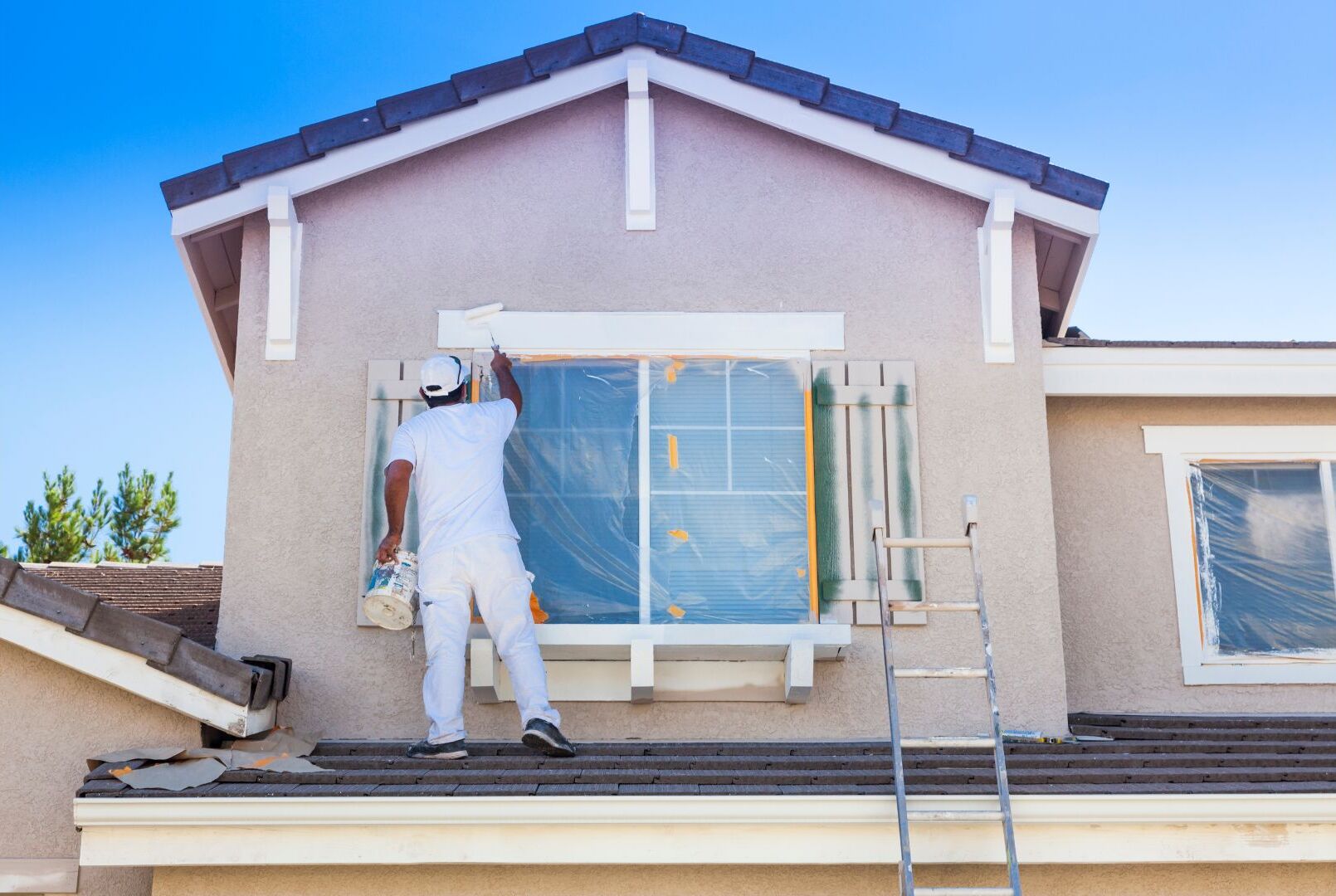
How Do Professional Painters Paint the Exterior of a House?
Painting the exterior of a house is no small feat. It requires a lot of preparation, attention to detail, and expertise to ensure that the paint job looks clean, crisp, and can withstand the elements for years to come. While some homeowners opt for the DIY route, hiring a professional painter ensures that you get a high-quality finish and that all the essential steps are followed. So, how do professional painters approach this task? Let’s dive in!
Understanding the Process
Before starting the painting process, a professional painter will assess the condition of the house, the type of siding or surface that needs painting, and the environment in which the house is located. Each of these factors will determine the steps they take to ensure a seamless paint job.
1. Detailed Inspection
Before even opening a paint can, professionals will inspect the exterior of the home for any signs of damage, mold, mildew, or other potential issues. They’ll check for rotted wood, peeling or flaking paint, and gaps or cracks that might need sealing.
2. Cleaning the Surface
A clean surface is essential for paint to adhere properly. Professional painters will often power wash the exterior of the house to remove dirt, grime, loose paint, and any other contaminants. This step ensures that the paint will bond with the surface, resulting in a longer-lasting finish.
3. Making Repairs
After cleaning, any damage or areas of concern identified during the inspection will be addressed. This can include patching holes, replacing rotting wood, or sealing gaps and cracks. These repairs are crucial as they prevent future issues and ensure the paint looks smooth and even.
4. Preparing the Site
Before painting starts, professionals will take steps to protect your home and its surroundings. This includes covering bushes, plants, and flowers with drop cloths or plastic sheeting and taping off windows, doors, and other areas that shouldn’t receive paint.

5. Priming the Surface
Not every paint job requires a primer, but in cases where the existing paint is very dark, peeling, or if bare wood is exposed, a primer is essential. It helps the paint adhere better and provides a uniform base, especially important when changing the color drastically.
6. Choosing the Right Paint
The type of paint used can significantly impact the outcome. Professionals know the best paints for different surfaces and environments. They’ll consider factors like the material of your siding, local climate, and your color preferences when recommending the best paint type.
7. Painting
With all the prep work done, the actual painting can begin. Using brushes, rollers, or sprayers, professionals will methodically paint the exterior, ensuring even coverage and crisp lines. Depending on the color and type of paint, they may apply multiple coats.
8. Regular Inspection
As they paint, professional painters will constantly check their work, ensuring that there are no drips, streaks, or missed spots. This ongoing attention to detail sets professionals apart.
9. Clean-up
Once the painting is complete, any drop cloths, tape, or other materials will be removed. The area will be cleaned, leaving your property as it was found, but with a beautifully painted exterior.
10. Final Walkthrough
After the job’s completion, the professional painter will often do a final walkthrough with the homeowner. This ensures that the work meets or exceeds expectations and allows for any final touch-ups or corrections if needed.
Painting the exterior of a house is a significant task, but with the right tools, knowledge, and experience, professional painters can transform a home’s appearance. When considering such a significant project, it’s worth considering professionals who bring expertise, attention to detail, and a commitment to excellence to the table. Not only will your home look fantastic, but the paint job will also last for years to come, proving to be a worthwhile investment.

Should You Try to DIY Painting the Exterior of Your House?
When it comes to home improvement projects, painting is often regarded as one of the more accessible tasks for homeowners. After all, many of us have tackled an interior room or two in our time. However, painting the exterior of a house is a different beast altogether. Before you decide to take on this challenge, let’s weigh the pros and cons of DIY versus professional exterior painting.
Pros of DIY Exterior Painting
- Cost Savings: One of the primary reasons homeowners consider DIY painting is the potential savings. By eliminating labor costs, you might save a significant chunk of change. However, remember that the savings might not be as significant as you think, once you factor in all the necessary equipment and materials.
- Personal Satisfaction: There’s a deep sense of achievement in completing a big project like painting your home. If you’re the type of person who takes pride in DIY tasks, the gratification can be worth the effort.
- Control Over the Project: Doing it yourself means you have complete control over every aspect of the job, from paint selection to how and when the work is done.
Cons of DIY Exterior Painting
- Time-Consuming: Painting the exterior of your house isn’t a weekend project. It can take considerable time, especially if you’re inexperienced. What professionals can accomplish in a few days might take weeks for a DIYer.
- Physical Demands: Exterior painting is hard, physical work. It involves climbing ladders, reaching, bending, and often working in unfavorable weather conditions.
- Risk of Mistakes: A mistake on an interior wall can be annoying. A mistake on the exterior of your house can be very noticeable and costly. Drips, streaks, or uneven application can detract from your home’s curb appeal.
- Safety Concerns: Falling from ladders, especially from significant heights, can lead to severe injuries. Professionals have the equipment and experience to work safely in these conditions.
- Hidden Costs: While you might save on labor, you’ll still need to purchase paint, brushes, rollers, sprayers, ladders, drop cloths, and other materials. Depending on the state of your exterior, you might also need to rent or buy power washers or other equipment.
Weighing the Decision
The choice to DIY or hire professionals comes down to a balance of time, cost, and quality. If you have ample time, are prepared for the physical demands, and are confident in your skills, DIY might be right for you. However, for many homeowners, the peace of mind that comes from hiring professionals — ensuring a high-quality, lasting result — is worth the extra cost. Whatever you decide, proper preparation, and understanding the scope of the task are key to a successful exterior paint job.

What Kind of Paint Will Professionals Use for Exterior Painting?
Selecting the right paint is crucial when it comes to exterior projects. The paint needs to withstand varying weather conditions, from the scorching sun to chilling frosts, torrential rain, and even occasional snow in certain regions. Professionals often have preferred brands and types based on their experience, but understanding the basics can help homeowners make informed decisions.
Water-Based vs. Oil-Based
There are two primary categories of paint: water-based (often called latex) and oil-based (alkyd).
Water-Based Paints:
- Advantages: They dry faster, have low odor, and are easy to clean up with just soap and water. They also tend to resist yellowing over time and remain flexible, reducing the likelihood of cracking.
- Usage: Many professionals and homeowners alike prefer water-based paints for their environmental benefits and ease of use.
Oil-Based Paints:
- Advantages: They are often more durable than their water-based counterparts and have a smoother finish, which can be particularly appealing on certain surfaces.
- Usage: While they take longer to dry and require mineral spirits for cleanup, they’re frequently chosen for surfaces that need a hard, glossy finish.
Factors Affecting Paint Choice
- Climate: The local weather plays a significant role in paint selection. Some paints are specially formulated to resist mildew or fading in sun-drenched areas, while others are designed to provide better protection against moisture.
- Surface Material: The material of the exterior surface—be it wood, brick, metal, or vinyl—can dictate the type of paint required. Each material has specific needs, and certain paints adhere better to specific surfaces.
- Finish Preference: Paints come in various finishes, from matte to high gloss. While matte finishes can help hide imperfections on older homes, semi-gloss and gloss finishes are more resistant to dirt and easier to clean.
Professional Recommendations
While specific brands and product lines may vary by region and availability, some of the top-recommended paints among professionals for exterior projects include:
- Behr Premium Plus Ultra: Known for its durability and wide range of finish options.
- Sherwin-Williams Duration: Renowned for its one-coat coverage and resistance to mold and mildew.
- Benjamin Moore Aura: Offers excellent color retention and resistance against weathering.
Professionals will often factor in the homeowner’s budget, the specific needs of the project, and their experiences with certain brands to recommend the best option.

While the paint type and brand a professional recommends can vary based on many factors, understanding the basics empowers homeowners to collaborate effectively with professionals. Whether prioritizing durability, finish, environmental concerns, or budget, there’s a suitable exterior paint for every project.
How Much Does it Cost to Hire Someone to Have Your Home’s Exterior Painted?
Painting the exterior of your home is an investment. Not only does it enhance the aesthetic appeal of your residence, but it also provides protection from the elements. Hiring a professional to do the job ensures quality work and takes the load off homeowners, but how much should you budget for this kind of project?
Factors Influencing Cost
The cost of painting a house’s exterior varies based on several factors:
- Size of the House: Naturally, a larger home will require more paint and labor, leading to higher costs. Most painting companies will base their price on the total square footage or the number of rooms.
- Type and Quality of Paint: Premium paints are more expensive but often provide better coverage, longevity, and resistance to environmental factors.
- Preparation Work: The condition of your home’s exterior will play a part in the overall cost. If there’s a need for significant prep work, like patching holes, sanding rough areas, or removing peeling paint, the labor and materials cost will increase.
- Complexity of the Job: Homes with intricate designs, multiple stories, or hard-to-reach areas can increase labor time and may even require specialized equipment or scaffolding.
- Geographical Location: Labor costs can vary significantly depending on where you live. Urban areas might have higher rates than rural areas.
- Time of Year: Some seasons are more popular for exterior painting, leading to increased demand and potentially higher prices.

Average Cost Estimates
While it’s essential to get quotes from local contractors to understand the exact pricing in your area, here are some general figures to provide a starting point:
- Small to Medium Homes: For homes ranging from 1,000 to 1,500 square feet, the cost, including labor and materials, can range from $2,500 to $5,000.
- Larger Homes: Homes between 2,500 and 3,500 square feet can expect costs to lie between $7,500 to $10,000.
- Additional Costs: If your project requires power washing before painting, it might add between $200 to $500 to the total. Likewise, major repairs or priming can also increase costs.
Getting the Best Value
To ensure you get the best value:
- Get Multiple Quotes: Speak to at least three reputable contractors in your area to understand the price range and what’s included in their services.
- Review Past Work: Check reviews or ask for references to understand the quality of work a contractor delivers.
- Ask About Warranties: Some professionals will offer warranties on their work, providing peace of mind and assurance of the job’s quality.
While the cost of having your home’s exterior painted can vary widely based on various factors, it’s an investment that can enhance your home’s value and curb appeal. Proper research and budgeting can ensure you get a fresh coat that looks great and lasts for years.
